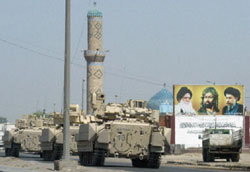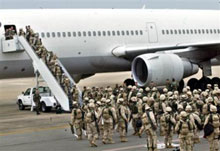|
Clashes Flare Up In Iraq, US Planes Hit Najaf
 |
|
US tanks roll past a picture of leading Shiite Muslim figures in Baghdad's predominantly Shiite Sadr City neighborhood (AFP)
|
BAGHDAD, August 6 (IslamOnline.net & News Agencies) – Chaos and
insecurity hit a new low in
Iraq
Friday, August 6, as fresh clashes between Iraqi fighters and US-led
occupation forces have led to over 50 people killed and over a hundred
wounded, including 15
US
soldiers wounded.
More
than 130 people were wounded as the unrest fanned out across Shiite
central and southern
Iraq, with clashes extended to engage British troops in
Basra, Italian troops in Nasiriyah and
US
troops in Shiite areas of
Baghdad
.
US
planes pounded the central holy city of
An-Najaf, where intense clashes were reported between US forces and Shiite
Muslim fighters in the worst fighting since a truce was agreed in
June, Agence France-Presse (AFP) reported.
Columns
of thick black smoke could be seen rising up from the city, as
residents stayed at home with their doors bolted and fighters loyal to
Shiite leader Moqtada Sadr – a firebrand known for his calls for an
end to occupation of the oil-rich country - prowled the streets.
US
planes fired rockets over the city and its cemetery, with the aerial
bombardment continuing as
US
tanks were seen moving from the 1920 Revolution Square to
Al-Midan Square.
Explosions
and gunfire crackled across An-Najaf , with no letup for the Muslim
day of rest after dozens of US tanks and armoured vehicles drove into
the holy city.
One
ambulance was set alight and burnt out civilian cars littered the
deserted streets, as sporadic gunfire rattled out across An-Najaf, an
AFP correspondent said.
Italian
troops are based on one side of the
Euphrates
river, with militiamen loyal to Sadr deployed on the other.
On
Saturday, August 1, US-led forces detained Sheikh Mithal Al-Hasnawi,
Sadr's representative in
Karbala, another Shiite holy city south of
Baghdad.
It
was the
US
arrest of one of Sadr's key deputies that helped trigger the firebrand
leader’s first standoff with the
US
occupation forces in the spring.
Holy
Sites Attacked

|
|
US troops in South Korea leave for Iraq |
In
Baghdad, 15
US
soldiers were wounded in attacks Thursday, at least six in the huge
Shiite neighborhood of
Sadr
City, the military said.
Medics
reported at least 26 people killed and 90 wounded during the clashes.
Sadr aides accused US troops of damaging a minaret of Najaf's holiest
shrine, the mausoleum of Imam Ali.
His
fighters marched through the streets, calling over loudspeakers for
Muslims to "take up arms to defend your holy places against the
occupiers".
War
Declared
In
Iraq's main southern city of
Basra, Sadr representative Sheikh Saad Al-Basri, who declared war on
British troops Thursday, August 5, said five people had been killed
and three wounded in two separate skirmishes there.
A
spokeswoman said British commanders would continue to negotiate with
local leaders in a bid to calm the situation, but the province's
deputy governor ruled out any question of talks.
"We
refuse any negotiations with the occupation forces," said Salem
Audeh.
In
Amara, five civilians were wounded when mortar rounds struck in the
center of the city, said a hospital doctor.
Clashes
In Sunni Areas
Clashes
also broke out in Sunni areas, when
US
forces used airpower in clashes in the Sunni Muslim city of
Samarra, north of
Baghdad.
Two
civilians were killed and 13 wounded, medics said Friday. Three
children were among the wounded, said a doctor at the city's main
hospital.
Fighting
began late Thursday near a bridge over the
Tigris
, said police colonel Abdel Haq Ismail. An AFP correspondent said
US
planes fired 11 rockets in the area.
The
US
military said troops had killed three fighters and detained nine
others in a series of overnight raids, much infuriating to the local
inhabitants.
"Operation
Cajun Mousetrap II" was based on "precise intelligence"
and was an "uncompromising effort to kill or capture anti-Iraqi
forces," a statement said.
Samarra
is home to one of Shiite Islam's holiest shrines but is predominantly
Sunni and has long been a bastion of resistance to the US-led
occupation forces.
More
Troops
Much
to the fury of Iraqis seeking an end to occupation of
Iraq, the
United States
airlifted hundreds more troops to their oil-rich country.
Hundreds
of US soldiers left for
Kuwait, US military authorities said, one day after an American US military
spokesman in
Baghdad
admitted that an American marine helicopter was shot down near
An-Najaf.
Some
600 soldiers of the 2nd Brigade Combat Team, 2nd Infantry Division
departed this
US
airforce base, 70 kilometers (44 miles) south of
Seoul, to help bolster the
US
military presence in the war-torn country.
The
airlift forms part of the redeployment of 3,600 troops from
South Korea
to
Iraq
announced in May by the US Department of Defense.
The
announcement of the pullout of 3,600
US
troops based near the highly-fortified border with
North Korea
caused security fears in
South Korea.
It
remains uncertain whether the brigade, whose withdrawal will cut US
troop numbers there from 37,000 to around 33,400, will return at a
later date.
Washington
said the pullout will help reinforce its hard-pressed military in
Iraq
.
Chairman
of the US joint chiefs of staff General Richard Myers said on July 2,
a force of 145,000 US troops may be needed in Iraq for as
many as five years.
The
statement was followed by Sadr’s calls on the Iraqis to step up
resistance since the US-led occupation has not ended yet.
USA
TODAY/CNN/Gallup poll has showed that 71% of nearly 3,500 Iraqis of
every religious and ethnic group see the US-led forces as "occupiers"
and not "liberators".
A
June 29 poll – one day after the power transfer - showed that a
sweeping majority of Iraqis, 80 percent, want the US-led
forces to keep to their
bases outside towns and make their presence less visible.
|